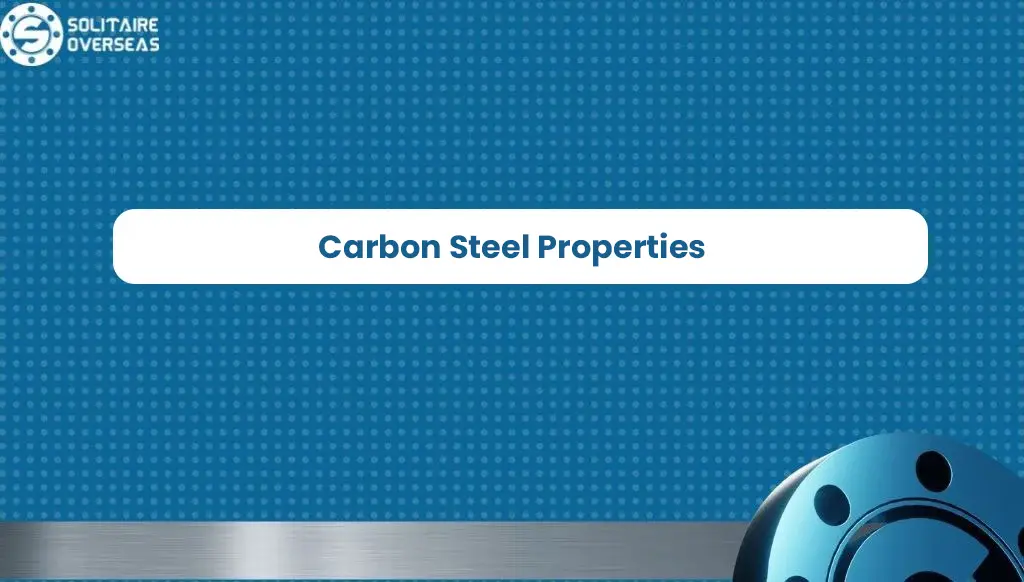Carbon Steel Properties & Applications

Carbon Steel: Properties, Production, Examples and Applications
Carbon steel, an iron-carbon alloy with a carbon content of up to 2.1 wt.%, plays a crucial role in metallurgy. Unlike other alloys, carbon steels don’t have a specified minimum content of additional elements, although manganese is commonly present. The alloy follows specific guidelines to keep manganese, silicon, and copper below 1.65 wt.%, 0.6 wt.%, and 0.6 wt.%, respectively.
Explore the features of carbon steel, from its inherent properties to the details of production, and discover real-world applications showcasing its importance in various industries.
Types of Carbon Steel and Their Properties
Carbon steel categorizes into three distinct types based on its carbon content: low-carbon steel (or mild-carbon steel), medium-carbon steel, and high-carbon steel . Here’s a comparison of their carbon content, microstructure, and properties:
Carbon content (wt.%) | Microstructure | Properties | Examples | |
|---|---|---|---|---|
Low-carbon steel | < 0.25 | Ferrite, pearlite | Low hardness and cost. High ductility, toughness, machinability and weldability | AISI 304, ASTM A815, AISI 316L |
Medium-carbon steel | 0.25 – 0.60 | Martensite | Low hardenability, medium strength, ductility and toughness | AISI 409, ASTM A29, SCM435 |
High-carbon steel | 0.60 – 1.25 | Pearlite | High hardness, strength, low ductility | AISI 440C, EN 10088-3 |
Low-Carbon Steel: Versatility and Ductility
Low-carbon steel stands as the most widely utilized form of carbon steel, characterized by a carbon content typically below 0.25 wt.%. Notable for its versatility, these steels lack the ability to harden through heat treatment, requiring cold work for martensite formation.
Key features of low-carbon steel include:
- Carbon Content:
- Typically contains less than 0.25 wt.% carbon.
- Hardening Mechanism:
- Inability to harden through heat treatment; cold work is employed for hardness.
- Mechanical Properties:
- Relatively soft with low strength.
- High ductility, making them excellent for machining, welding, and cost-effective applications.
High-strength, low-alloy steels (HSLA) are a subgroup of low-carbon steels, incorporating additional elements like copper, nickel, vanadium, and molybdenum (up to 10 wt.%). Achieving enhanced strength through heat treatment, HSLA steels maintain ductility, ensuring ease of forming and machining. Moreover, they exhibit improved corrosion resistance compared to plain low-carbon steels.
Low-carbon steel’s widespread use in various industries attests to its adaptability, offering a balance of mechanical properties suitable for an array of applications. Understanding its characteristics enables informed material selection for diverse engineering needs.
Medium-Carbon Steel: Strength and Heat Treatment
Medium-carbon steel, encompassing a carbon content of 0.25 – 0.60 wt.% and manganese ranging from 0.60 – 1.65 wt.%, represents a category offering improved mechanical properties. The enhancement is achieved through a specific heat treatment process involving austenitizing, followed by quenching and tempering, resulting in a martensitic microstructure.
Key characteristics of medium-carbon steel include:
- Carbon and Manganese Content:
- Carbon content ranges from 0.25 – 0.60 wt.%, with manganese content between 0.60 – 1.65 wt.%.
- Heat Treatment for Improvement:
- Mechanical properties are enhanced through heat treatment involving austenitizing, quenching, and tempering.
- Additional Alloying Elements:
- Alloying elements like chromium, molybdenum, and nickel can be added to facilitate heat treatment and improve hardening ability.
- Strength vs. Ductility/Toughness Trade-off:
- Hardened medium-carbon steels exhibit greater strength compared to low-carbon steels.
- However, this strength enhancement comes at the expense of reduced ductility and toughness.
While heat treatment is effective on thin sections, the addition of alloying elements broadens the scope of heat-treatability. This versatility allows for tailored properties based on specific applications. Understanding the trade-offs between strength, ductility, and toughness in medium-carbon steel enables informed material selection for projects requiring a balance between these mechanical characteristics.
High-Carbon Steel: Hardness, Toughness, and Wear Resistance
High-carbon steel, featuring a carbon content of 0.60 – 1.25 wt.% and manganese content of 0.30 – 0.90 wt.%, represents the pinnacle of carbon steels in terms of hardness and toughness. However, this robustness comes at the expense of reduced ductility. High-carbon steels are renowned for their wear resistance, primarily attributed to the standard practices of hardening and tempering.
Key attributes of high-carbon steel include:
- Carbon and Manganese Content:
- Carbon content ranging from 0.60 – 1.25 wt.%, and manganese content from 0.30 – 0.90 wt.%.
- Hardness and Toughness:
- Exhibits the highest hardness and toughness among carbon steels.
- Lower ductility compared to other types of carbon steel.
- Wear Resistance:
- Known for exceptional wear resistance due to common hardening and tempering practices.
- Tool and Die Steels:
- Tool steels and die steels, subcategories of high-carbon steels, incorporate additional alloying elements such as chromium, vanadium, molybdenum, and tungsten.
- These elements contribute to the formation of carbide compounds like tungsten carbide (WC), resulting in extremely hard and wear-resistant steel.
High-carbon steel finds extensive use in applications demanding superior wear resistance, making it ideal for tools, dies, and components subjected to abrasive conditions. The strategic addition of alloying elements further enhances its hardness, contributing to its impressive performance in various industrial settings. Understanding the unique characteristics of high-carbon steel aids in precise material selection for wear-intensive applications.
Production and Processing of Carbon Steel
Carbon steel, a versatile material with widespread applications, can be produced through various methods, involving both recycled and virgin steel.
- Sources of Carbon Steel:
- Carbon steel can be derived from recycled steel, virgin steel, or a combination of both.
- Virgin Steel Production:
- Virgin steel is manufactured through a process that involves combining iron ore, coke (derived from heating coal without air), and lime in a blast furnace operating at approximately 1650 °C.
- In this process, the iron ore is melted, and carbon from the burning coke enriches the molten iron. Impurities combine with lime to form slag, which floats on the molten metal for extraction.
- Carbon Content Adjustment – Decarburisation:
- The resulting molten steel typically contains around 4 wt.% carbon.
- Decarburisation is the subsequent step, where the carbon content is adjusted to the desired level.
- This process involves passing oxygen through the melt, leading to the oxidation of carbon in the steel. The result is the production of carbon monoxide and carbon dioxide, reducing the carbon content.
Understanding the production and processing stages of carbon steel sheds light on the intricacies of creating a material with tailored properties. Whether from recycled or virgin sources, carbon steel’s versatility stems from well-controlled manufacturing processes that ensure its suitability for a wide array of applications.
Examples & Applications of Carbon Steel Grades
Low-Carbon Steel:
- Applications:
- Automobile body components
- Structural shapes (I-beams, channel and angle iron)
- Pipes
- Construction and bridge components
- Food cans
Medium-Carbon Steel:
- Applications:
- Railway tracks
- Train wheels
- Crankshafts
- Gears and machinery parts requiring high strength, wear resistance, and toughness
High-Carbon Steel:
- Applications:
- Cutting tools
- Springs
- High-strength wire
- Dies
Each grade of carbon steel finds its niche in various industries, showcasing the adaptability and strength of this versatile material. From supporting structures in construction to withstanding the demands of railway tracks, carbon steel grades play a crucial role in shaping the world around us. Understanding their specific applications allows for informed material selection, ensuring optimal performance in diverse engineering and manufacturing scenarios.
Comparison of properties and applications of different grades
Carbon content (wt.%) | Microstructure | Properties | Examples | |
|---|---|---|---|---|
Low-carbon steel | < 0.25 | Ferrite, pearlite | Low hardness and cost. High ductility, toughness, machinability and weldability | AISI 304, ASTM A815, AISI 316L |
Medium-carbon steel | 0.25 – 0.60 | Martensite | Low hardenability, medium strength, ductility and toughness | AISI 409, ASTM A29, SCM435 |
High-carbon steel | 0.60 – 1.25 | Pearlite | High hardness, strength, low ductility | AISI 440C, EN 10088-3 |
Conclusion:
In summarizing the varied world of carbon steel grades, it’s clear that low-carbon steel excels in affordability and adaptability, serving applications like automobile components and construction. Medium-carbon steel, known for its strength and toughness, finds utility in railway tracks and machinery parts. High-carbon steel, prized for its wear-resistance, takes the lead in cutting tools and springs. The production processes, whether using recycled or virgin steel, underscore the precision in achieving desired properties. From blast furnaces to decarburisation, this journey shapes a material that stands as a cornerstone in modern infrastructure, contributing indispensably to the strength and efficiency of structures and tools shaping our daily lives.
